|
| |
Page Two
From a pursuing locomotive constables pour a
steady rat-tat-tat of bullets at the fleeing Toad. Putting arms in the hands
of the British police (who never carry guns) represents the movie's only
sizable distortion of English life.
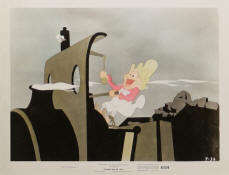
On a stolen locomotive the disguised Mr.
Toad shrieks out his full joy in rapid travel as he races through the night
in the direction of his native countryside. There he intends to take revenge
on the malefactors who sent him to prison. |
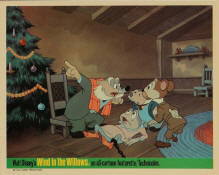
Mr. Toad seeks the help of his friends, Mole, MacBadger
and Rat, to find the deed to Toad Hall. He tells them it will prove he
didn't steal the car. |
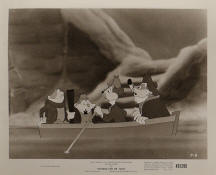
Mr. Toad, Mole, MacBadger
and Rat, prowl through the
underground passages beneath Toad Hall to surprise Winkey and the weasels
who have taken over the premises. |
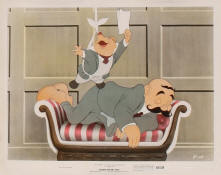
The deed to Toad Hall is noiselessly
retrieved from pocket of the sleeping Winkey by Mole, who has been lowered
from a balcony by his friends. But a watchful weasel interrupts just as
Mole is being pulled back up. |
"The final fight to reclaim Toad Hall features some classic slapstick
action as the weasels try and stop Toad and company from getting the deeds
to the building."
—Nathanael
Smith,
Animation Confabulation
 Ichabod and Mr. Toad Ichabod and Mr. Toad
AUDIENCE SLANT: (Family) Giving his version of two literary classics,
Disney is at his best.
BOX-OFFICE SLANT: Disney, Crosby songs and narration and two
classic stories upon which the film is based should start 'em
thronging and word-of-mouth will keep 'em coming in droves.
Plot: J. Thaddeus Toad is a wealthy but irresponsible
English sportsman who, despite the aid of his friends MacBadger, Water
Rat and Mole, is sent to jail for allegedly stealing a motor car. He
escapes and the group invades Toad's ancestral mansion to recover the
deed to it from the gang of weasel crooks. ... Ichabod Crane,
grotesque itinerant school teacher in pre-revolutionary America,
aspires to marry the daughter of the richest man in town but he is
frightened out of the territory by a "headless horseman"—his
rival in disguise.
Comments: Two literary classics irresistible to persons of
all ages have been made into a single cartoon feature in which Walt
Disney is at his best. It should attract and delight audiences of
adults and children that will grow tremendously with word-of-mouth
praise that is assured. the first portion of the film relates Kenneth
Grahame's "The Wind in the Willows" (1933), an animal portrayal of
English country life. Basil Rathbone narrates this part perfectly, and
Disney's irrepressible Toad is one of his most endearing creations.
Laughs and action follow the irresistible chap everywhere he turns.
Bing Crosby narrates the second half of the program, which is based
upon Washington Irving's "The Legend of Sleepy Hollow," of early
Tarrytown, N.Y., setting. Bing breaks into a few catchy ditties which
may help herald the picture. Only slightly less winning than the
animals of "Mr. Toad, " Disney's human characters (also portrayed
entirely in cartoon form) in "Ichabod" have the advantage of greater
familiarity to American audiences. "Ichabod and Mr. Toad" is a prize
item, and ranks with the best Disney has brought to the screen.
—Showmen's Trade Review, August 27, 1949 |
"Both of the stories are handled extremely well, and the action chase
sequences that close each 'act' are well above average in pace and editing,
rivaling the best of Disney and making for some very excitable movie-making.
Rathbone’s voice on Mr. Toad is superb, adding a sense of atmospheric
“reality” to the tale and covering plot points that might have made scenes
themselves in a longer, feature version of the story."
—Ben Simon,
Animated Views
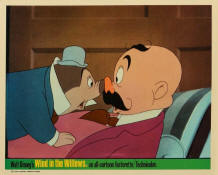
Mole lands on Winky, waking him up! |
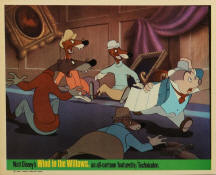
The chase is on as the weasels endeavor to retrieve the deed. |
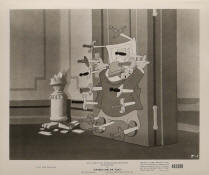
The runaway Mole finds himself
the target of a great mass of daggers thrown across the hall by the
wicked weasels. |
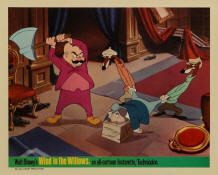
The captive Mole, held fast by two weasels,
is about to feel the full weight of Winkey's wrath. but a diversion created
by his friends who are fighting weasels in another part of the hall enables
him to wriggle out of their grasp and flee. |
"In a number of ways, The Wind in the Willows is unlike anything else
Disney has put to film, which makes it stand out and above from the rest of
the films from Walt's time. Both The Wind in the Willows and The Legend
of Sleepy Hollow ... complement each other with their effective adaptation
of the written word, their contrasting but equally engaging tones and
characters, and their wonderful artwork and composition."
—Ultimate Guide to Disney DVD
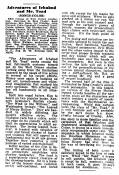 "The Adventures of Ichabod and Mr.
Toad" ranks among the best full-length cartoons turned out by the Walt
Disney studios. Cutting away from the limitations imposed by the usage
of live actors in several of his recent efforts, Disney once again is
banking on that wit, inventiveness and whimsical imagination that
marked his early successes. This offering will pay off handsomely in
all situations. "The Adventures of Ichabod and Mr.
Toad" ranks among the best full-length cartoons turned out by the Walt
Disney studios. Cutting away from the limitations imposed by the usage
of live actors in several of his recent efforts, Disney once again is
banking on that wit, inventiveness and whimsical imagination that
marked his early successes. This offering will pay off handsomely in
all situations.Split into equal halves, film is based
on two popular books, Kenneth Grahame's English classic, "The Wind in
the Willow," and Washington Irving's "The Legend of Sleepy Hollow."
They are handled in widely differing, but equally effective styles.
The Grahame yarn has a subtle, satirical edge on its comedy which will
limit its appreciation to adult audiences. The Irving legend, however,
is treated with splashes of color and broad strokes of humor and
violence that will appeal in a fundamental way to all age groups.
Together they comprise a solid package of varied entertainment.
Initial section of the film is devoted the adventures
of Mr. Toad, an aristocratic amphibian with playboy tendencies. The
toad is a superlatively clever creature of the drawing-boards. He is a
member of the leisure class, cultured, archly self-confident, and
bored with life except for his mania for autos and airplanes. When he
gets pinched on a stolen car rap, the toad acts as his own counsel
and, through the cartoon's power of parody, exposes the prosecution's
legal cliches with insouciant nonchalance. It's the high point of the
film.
The dialog and narration are impeccably tailored to
match the animation. Basil Rathbone, handling the biggest assignment,
Eric Blore and the other voices impart to the script that proper
British toniness and dry humor which will undoubtedly pass over the
heads of the youngsters. But even in this section, the kids will get a
kick out of the personifications of the various animal characters,
including a stiff-collared Mr. Rat, an easy-going Mr. Pig and a gang
of weasel hoodlums.
The second half of the film is dominated by Bing
Crosby's soundtrack personality. In this hoked-up version of the
Sleepy Hollow legend, Crosby handles all the narration, plays all the
characters and nearly renders a couple of spook-tunes with the
Rhythmaires accompanying. While this cartoon lacks the class of "Mr.
Toad," it is still firstrate and will probably be the pic's major b.o.
draw, chiefly because of Crosby. Also, the story is more familiar and
the caricature of that fabulous and frightened schoolmaster, Ichabod
Crane, is drawn in a more immediately recognizable comic vein. The
sequence in which Ichabod meets the Headless Horseman in the forest,
incidentally, matches anything Disney has ever done in the way of
terrifying the younger set.
The tinting of both yarns is skillfully keyed to the
tone of each yarn. While "Mr. Toad" is drawn in soft pastels, the
Ichabod yarn is swept by full, contrasty colors. In both cases, it
pars Disney's standard for excellence.
Herm.
—Variety, August 24, 1949 |
"The Wind in the Willows ...
has some of the finest work the studio ever did." —Leonard Maltin, The Disney Films
(Disney Editions, 2000)
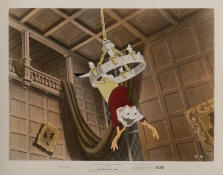
Swinging from the chandelier, Mr. Toad manages to save Mole from Winky's
axe. |
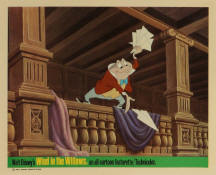
Throwing paper airplanes so weasels won't know which one is the deed. In
the confusion, Toad grabs the real deed. |
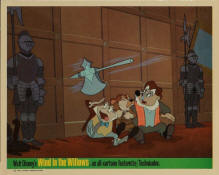
The four friends make good
their escape from the frantic band of villains. |
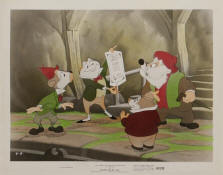
The deed is displayed by Mr. Toad. He can now have the real
criminals put in prison and return to his former abode, where he promises to
live a quieter, more sensible life. |
A new mania takes shape just as Mr.
Toad's friends are congratulating themselves on his promise to quiet down.
The Mr. Toad segment of the film ends with Mr. Toad swooping down on his
friends in an early-model airplane, shouting about travel,
change, and excitement!
 THE ADVENTURES OF ICHABOD AND MR. TOAD THE ADVENTURES OF ICHABOD AND MR. TOADThe title is
apt to obscure the fact that this film consists of two stories joined
by the slenderest of threads, first the adventures of Toad, from
Kenneth Grahame's "The Wind in the Willows," and then the tale of
Ichabod Crane by Washington Irving.
A number of critics have been very pleased with this
Mr. Toad and his irrepressible and irresponsible preoccupation with
the newest and fastest forms of transport. But there has been a
dissenting judgment which suggests that Disney has not quite made the
grade. With this I am inclined to agree, largely, I think, because I
am irritated by American efforts to be just too, too terribly English
(or, in the case of MacBadger, Scottish).
Ichabod had earned little commendation. Visually a
period piece, its sound track has been adapted to contemporary taste
by the insertion of "close harmony," and boo-boo-booing. (But those
who think that Bing Crosby should stick to golf will be relieved to
know that he does not sing much.) Katrina, who is courted by Ichabod,
the gaunt schoolmaster, is a sort of sophisticated Snow White.
Horrifics are represented by the headless horseman. Personally I can
never think of this celebrated apparition without recalling with a
chuckle the late lamented Moore Marriott and his leering enthusiasm
for the 'eadless 'orseman, but young children should be spared a
potential nightmare.
The word Ichabod has associations with departed
glory. and this is not vintage Disney.
Q.
—Focus Film Review, August 1950 |
"Basil Rathbone's clipped narration is entirely in keeping with the tone
of this fairy tale of rural England."
—New York Times, October 10, 1949
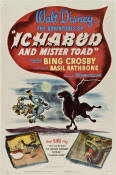
1-sheet poster |

3-sheet poster |
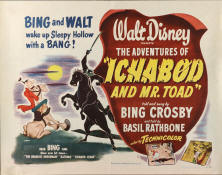
half sheet poster |

insert |
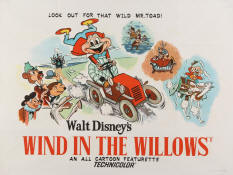
British quad poster |

Australian daybill |
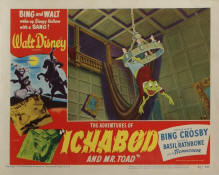
lobby card |
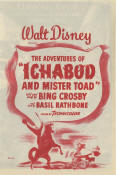
herald |
The two promotional photos below
were taken in 1965, and used in connection with the Wind in the Willows
portion of the film appearing
on television.
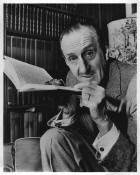
Basil Rathbone, 1965 |
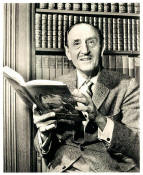
Basil Rathbone, 1965 |
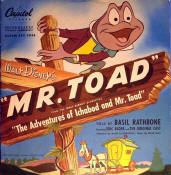
the cover of the record |
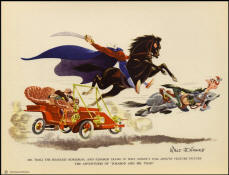
fan card |
In 1949,
to tie in with the release of the film,
Capitol Records issued an album called "Mr. Toad," featuring Basil Rathbone narrating
and the cast of the film. The record was available in two formats: Capitol
EAS-3048 (a 12-inch, 78 rpm record) and Capitol KASF-3048 (a 7-inch, 45 rpm
record). Both versions had a gatefold cover.
You can listen to the record on YouTube: https://youtu.be/n9BKIjvswJY
Images on this page are from The
Adventures of Ichabod and Mr. Toad, copyright Walt Disney
Studios.
Return to Page One.
|
|
































